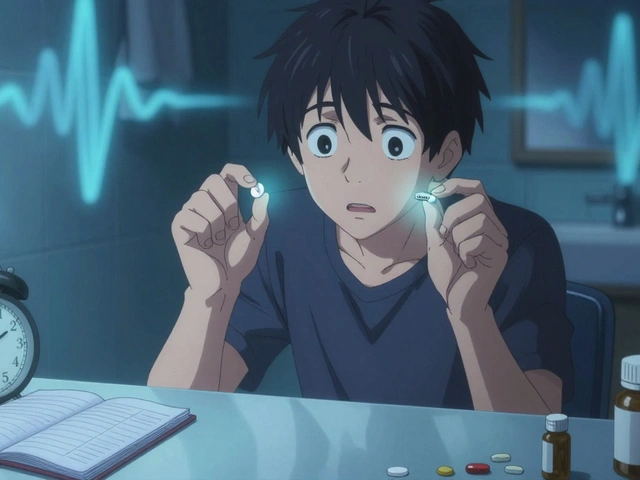When you’re taking a generic medication for high blood pressure, diabetes, or cholesterol, it’s easy to assume the pill is doing its job-until it isn’t. Nearly half of all patients stop taking their generic drugs within a year. Not because they feel better. Not because they can’t afford them. But because they forget. Or get overwhelmed. Or think it’s fine to skip a dose if they feel okay that day. And that’s where digital adherence tracking comes in-not as a luxury, but as a necessity.
Why Generics Need Tracking More Than Brand Names
Generic medications make up 90% of all prescriptions in the U.S. They’re cheaper, just as effective, and often the only option for people on tight budgets. But here’s the problem: while brand-name drug companies pay for adherence programs-like free apps, text reminders, and nurse hotlines-generic manufacturers rarely do. There’s no financial incentive. So patients are left on their own. That’s a big deal. Medication non-adherence costs the U.S. healthcare system $300 billion every year. And a huge chunk of that comes from people not taking their generics for chronic conditions like hypertension, Type 2 diabetes, or heart failure. The result? More hospital visits. More complications. More deaths that could have been avoided.How Digital Tools Actually Work
Digital adherence tools aren’t just smartphone alarms. They’re systems built to prove you took your pill-not just say you did. Here’s how the main types work:- Smart pill bottles like MEMS AS use electronic caps that record every time you open the bottle. They sync to the cloud and send alerts if you miss a dose. Used in clinical trials, they’re considered the gold standard for accuracy.
- Smart pillboxes like Tenovi have built-in lights (red for missed, green for done) and cellular connections. They track up to four medications at once and send real-time updates to your pharmacist or family.
- Electronic blister packs from Wisepill pop open only at the right time. If you don’t open it, the system knows. No guesswork.
- Video monitoring like VDOT lets you record yourself taking your pill. It’s used mostly for tuberculosis and other serious conditions, but it’s 95% accurate-if you’re willing to do it every day.
These tools don’t just remind you. They create a digital paper trail. For your doctor. For your pharmacist. Even for your insurance company. And that’s becoming more important every year.
What Works-and What Doesn’t
Not all tools are created equal. Some are designed for research labs. Others are built for busy families. Here’s what real users and providers say:- MEMS AS is incredibly accurate. But it’s expensive and clunky for daily use. Most patients find it too technical. It’s great for clinical trials, but not for your grandma taking her blood pressure pills.
- Tenovi Pillbox is the most popular with patients. The color-coded lights are simple. The app is easy. But the battery dies every few days. One user on Amazon said, "It’s life-changing-until it runs out of power." And the monthly fee? $30. That adds up fast.
- McKesson APS is used by pharmacies to track refill patterns. But here’s the catch: it doesn’t know if you actually swallowed the pill. It just knows you picked it up. That’s why it’s only 80-85% accurate at best.
- Basic reminder apps like Medisafe or MyTherapy? They’re free and easy. But studies show they only improve adherence by 10-15%. People ignore them. Or uninstall them after a week.
The best results come from combining tools. A 2022 AHRQ study found that patients on five or more medications who got both a smart pillbox and a 5-minute chat with their pharmacist saw a 35% improvement in adherence. That’s not magic. That’s human support meeting technology.
Cost, Access, and the Real Barriers
You might think, "Why not just give everyone a smart pillbox?" But here’s the reality:- A Tenovi device costs $149 upfront, plus $30 a month. Most insurance doesn’t cover it.
- Only 38% of Medicare Advantage plans pay for remote therapeutic monitoring-most of which includes adherence tools.
- Independent pharmacies, which serve the most vulnerable patients, have only an 18% adoption rate. They can’t afford the tech or the staff to manage it.
- Patients with low digital literacy struggle. If you’ve never used a smartphone to pay a bill, asking you to sync a pillbox is unrealistic.
And then there’s privacy. A 2022 AHRQ survey found 63% of patients worry about who sees their adherence data. Will your employer find out? Will your insurer raise your rates? These aren’t paranoid fears. They’re valid concerns in a system that already penalizes people for being sick.
What’s Changing in 2025
The landscape is shifting. CMS now includes medication adherence in Medicare Star Ratings. That means pharmacies and insurers get paid more if their patients take their pills. Suddenly, there’s a financial reason to invest in tracking. In March 2023, AARDEX updated MEMS AS with algorithms specifically for generic regimens. Tenovi now integrates directly with Epic and Cerner-major electronic health record systems. CVS Health is testing AI that predicts who’s likely to stop taking their meds based on refill patterns, appointment no-shows, and even weather. And here’s the kicker: every $1 spent on adherence programs for cardiovascular generics returns $7.20 in avoided hospital costs. That’s not a guess. That’s from the New England Journal of Medicine Catalyst. If you’re a pharmacy, a clinic, or a health plan, that’s a no-brainer.What You Can Do Today
If you’re taking generics and struggling to stay on track:- Ask your pharmacist: "Do you have a digital adherence tool I can use?" Don’t wait for them to offer it.
- If you’re on Medicare, call your plan and ask if remote therapeutic monitoring is covered. It might be.
- Try a simple app like Medisafe first. If it works, great. If not, ask about a physical device.
- Get a family member involved. One study found patients who shared their adherence data with a loved one were 40% more likely to stick with their meds.
- Don’t feel guilty if you miss a dose. Just tell someone. A tracker isn’t a spy. It’s a safety net.
If you’re a provider or pharmacy owner:
- Start with McKesson APS or a similar dashboard. It’s affordable and gives you data you already have.
- Train one staff member to spend 5 minutes with high-risk patients at pickup. That’s all it takes.
- Look for grants. Some state health departments fund adherence programs for chronic disease patients.
- Don’t push tech on everyone. Some people need phone calls. Others need pill organizers. One size doesn’t fit all.
Final Thought: It’s Not About Technology. It’s About Trust.
The most effective adherence tool isn’t a smart bottle or a glowing pillbox. It’s a pharmacist who remembers your name. A nurse who calls when you haven’t refilled in 45 days. A family member who asks, "Did you take your pill today?" Technology just makes those human connections easier to see-and to prove. When you can show a doctor that you took your medication every day for six months, they’re more likely to believe you when you say you’re feeling better. And that’s how you break the cycle of mistrust, neglect, and worsening health.Adherence tracking for generics isn’t about surveillance. It’s about support. And in a system that often forgets the people taking the pills, that’s worth fighting for.
Do insurance plans cover digital adherence tools for generics?
Most insurance plans, including Medicare, do not routinely cover smart pillboxes or adherence apps. Only 38% of Medicare Advantage plans reimburse for remote therapeutic monitoring as of late 2023. Some private insurers cover it for specific chronic conditions like heart failure or COPD if prescribed by a doctor. Always check with your plan before purchasing a device.
Can I use my smartphone app instead of a smart pillbox?
Yes, but with limits. Apps like Medisafe or MyTherapy are free and easy to use, and they help some people remember doses. But they rely on self-reporting-you have to manually log each pill. Studies show they improve adherence by only 10-15%. Smart pillboxes automatically detect when a pill is taken, which is far more accurate and reliable for clinical use.
Are digital adherence tools safe for older adults?
Many are designed specifically for older adults. Tenovi’s pillbox, for example, uses large buttons and color-coded lights instead of small screens. But devices with complex apps or Wi-Fi setup can be challenging. Look for tools with phone-based alerts, simple interfaces, and free tech support. Always involve a family member or caregiver in the setup process.
How do pharmacies use adherence data?
Pharmacies use adherence data to identify patients at risk of stopping their meds, reduce unnecessary refills, and improve patient outcomes. Systems like McKesson APS show which patients are falling behind, so pharmacists can reach out. Some pharmacies even get paid more by insurers if their patients maintain high adherence rates-especially for diabetes and hypertension generics.
Can adherence data be used against me?
Legally, your adherence data cannot be used to deny insurance or raise premiums. HIPAA protects it as medical information. However, some patients worry insurers might use it to flag "non-compliant" behavior. While no widespread cases exist, the concern is real. Always ask how your data is stored, who can access it, and whether it’s shared with third parties.
What’s the most affordable way to start tracking?
Start with a free app like Medisafe or MyTherapy. Pair it with a simple pill organizer that has compartments for each day. Then, ask your pharmacist if they offer a free adherence check-in during your refill. Many do. These low-cost steps can improve adherence by 20-30% without spending a dime on tech.








Bruce Hennen
Let’s be clear: if you can’t remember to take a pill once a day, you’re not a patient-you’re a liability. Digital tracking isn’t optional; it’s the bare minimum for managing chronic disease. The fact that 90% of prescriptions are generics doesn’t mean they’re disposable. Your body doesn’t care if it’s branded or generic-it just needs the dose. Stop romanticizing forgetfulness. This isn’t about convenience. It’s about survival.
And yes, I’ve seen the data. The $300 billion cost isn’t theoretical. It’s your neighbor’s ER visit. It’s your uncle’s stroke. It’s your tax dollars funding preventable disaster. If your solution is ‘just ask your pharmacist,’ you’re not solving the problem-you’re outsourcing your negligence.
Smart pillboxes aren’t luxury gadgets. They’re medical devices. And if your insurance won’t cover them, that’s a systemic failure. Not your fault. But still not an excuse.
Stop calling it ‘surveillance.’ It’s accountability. You wouldn’t skip your car’s oil change because you ‘felt fine.’ Why treat your heart like an afterthought?
And for the love of god, stop using apps that require manual logging. If you’re too lazy to press a button, you’re too lazy to live.
There’s no moral high ground in non-adherence. Just consequences.
Jake Ruhl
Okay so here’s the thing nobody’s saying but everyone’s thinking-this whole digital tracking thing is just the government’s way of spying on us under the guise of ‘health’ right like they already know what we eat how much we sleep and now they wanna know when we swallow our pills like what’s next a chip in our teeth that pings every time we breathe too deep
And don’t even get me started on the $30 monthly fee for a plastic box that dies every few days like who designed this system a broke intern on caffeine and desperation
Also I saw a guy on TikTok say his pharmacist sold his adherence data to a pharmaceutical company and now he’s getting ads for blood pressure meds in his Facebook feed like hello I’m already taking them why am I being targeted like I’m a walking wallet
And don’t tell me HIPAA protects me because I’ve read the fine print and it says ‘unless used for research or shared with third-party partners’ which sounds like corporate legalese for ‘we’ll sell your data and call it healthcare innovation’
They want us to trust the system but the system doesn’t trust us
So why should we trust them
And what happens when the algorithm decides you’re ‘non-compliant’ and cuts your benefits
That’s not healthcare
That’s control
Chuckie Parker
America spends billions on bandaids while the foundation crumbles. We have the tech to track pills but we don’t fund it because we’d rather pay for hospital beds than prevent them. This isn’t about individual responsibility. It’s about broken policy. The system incentivizes sickness not health. Insurance companies don’t care if you live or die as long as they’re not paying for it upfront. That’s why they won’t cover smart pillboxes. Because prevention is expensive. Reaction is profitable.
And don’t get me started on the myth of ‘patient empowerment.’ You don’t empower someone by handing them an app they don’t understand and then blaming them for not using it. You empower them by giving them access. By funding it. By making it free. By training staff to help. Not by slapping on a digital bandage and calling it innovation.
Stop pretending this is a tech problem. It’s a moral failure.
And if you think grandma can figure out Wi-Fi syncing? You’ve never met a 78-year-old with arthritis and no smartphone experience.
Fix the system. Not the patient.
George Hook
I’ve worked in community pharmacy for 22 years. I’ve seen people skip doses because they’re afraid of side effects. Because they can’t afford the copay. Because they’re ashamed. Because they think their doctor thinks they’re dumb for forgetting.
Technology helps. But it doesn’t fix the loneliness. The stigma. The fear.
I had a patient last month-73, diabetic, lives alone. She used a pill organizer with alarms. But she never told anyone she missed doses. Until one day she showed up crying because she hadn’t taken her metformin for three days and didn’t know what to do.
I didn’t give her a smart box. I sat down. I asked her why. She said no one ever asked.
That’s the real gap. Not the tech. The human connection.
Apps can remind. But only a person can listen.
So yes, use the tools. But don’t mistake efficiency for care.
And if you’re a provider-pick up the phone. Even once a month. It changes everything.
Hannah Magera
I love how this post doesn’t just throw tech at the problem but actually asks what works for real people. I’m a caregiver for my mom who’s on five meds. We tried Medisafe-it got deleted after a week. Then we got a Tenovi box. It’s great. But the battery dies every 3 days and she hates charging it. So now we just use a big paper chart and I call her every morning at 8.
Simple. Free. Human.
And honestly? She says she feels less like a patient and more like someone who’s cared for.
Technology should serve people, not the other way around.
Also-thank you for mentioning that 35% improvement stat. That’s the kind of number that should be shouted from rooftops.
Not every solution needs a Wi-Fi connection.
Jacob Hepworth-wain
Just got my first smart pillbox last month. Tenovi. Was skeptical. Now I’m hooked. I’m on meds for hypertension and anxiety. Used to forget. Now I get a green light. My wife gets a text. My doctor sees the report. It’s not about being watched. It’s about being supported.
Yes it costs money. But I spent $2000 on ER visits last year from skipping doses. This box paid for itself in 3 months.
And the app? Super simple. No typing. No logging. Just open the box. Done.
If you’re struggling-try it. Even for a month. Worst case? You learn what works. Best case? You stay healthy.
Also-ask your pharmacist. They’re not paid to push tech. But they’re paid to keep you alive. They’ll help.
Craig Hartel
As someone from India who moved to the US last year, I was shocked at how little support there is for chronic disease management here. Back home, my aunt took her pills every day because the local pharmacist called her every week. No app. No box. Just a phone call.
That’s the model we need. Not fancy gadgets. Just consistent care.
And I love that you mentioned the $7.20 return on every $1 spent. That’s not a stat. That’s justice.
Why are we still debating this?
Also-don’t underestimate the power of a family member asking, ‘Did you take your pill today?’ That question changes lives.
Technology helps. But love? That’s the real tracker.
Chris Kahanic
The data is compelling. The solutions are available. The barriers are structural, not behavioral. The fact that only 18% of independent pharmacies adopt these tools speaks volumes about funding inequities. Rural clinics, safety-net providers, and community pharmacies are on the frontlines-but they’re the last to receive resources.
Adherence tracking isn’t a consumer product. It’s public health infrastructure. And we treat it like a retail accessory.
Until CMS and private payers prioritize reimbursement for low-cost, high-impact tools-especially for vulnerable populations-we’re just rearranging deck chairs on the Titanic.
Also: privacy concerns are valid. Data governance frameworks must be transparent and patient-controlled. Not corporate-controlled.
Geethu E
My mom is 72 and takes 6 pills daily. We tried every app. She hated them. Then we got a simple pillbox with alarms. It didn’t sync to anything. Just beeped. And I called her every morning. That’s it.
She says she feels loved, not monitored.
And guess what? Her BP is stable for the first time in 5 years.
Stop overcomplicating this. Human connection + basic tool = victory.
Also, in India we don’t need $149 boxes. We need someone to care. And that’s free.
anant ram
Let’s be real: if you’re taking generics for hypertension, you’re probably poor, elderly, or both. And you’re being asked to navigate a $149 gadget with Wi-Fi, Bluetooth, app syncing, cloud backups, battery charging, and privacy policies written in legalese that even lawyers can’t read.
Meanwhile, your neighbor’s Medicare plan pays for a $500 MRI every month-but won’t cover a $150 pillbox that could prevent a stroke?
It’s not that people don’t care-they’re being asked to solve a system failure with their own time, money, and tech skills.
And yes, I’ve used Medisafe. It’s useless. You have to remember to open it. You have to remember to press the button. You have to remember you’re sick.
That’s not adherence. That’s performance.
What we need is a pillbox that works like a smoke alarm: simple, silent, automatic, and mandatory.
Not a smartphone app. Not a sales pitch. Just a box that saves lives.
And if you’re a provider? Stop asking patients to fix the system. Fix it yourself.
Kim Clapper
While the data presented is statistically sound, one must question the underlying assumption that patient non-adherence is a problem to be solved through technological surveillance. The real issue is not that patients forget-they are systematically abandoned by a healthcare system that commodifies illness while pathologizing human frailty. The notion that a smart pillbox is a 'necessity' is a neoliberal fantasy that absolves institutions of responsibility. Why not fund universal healthcare? Why not eliminate cost-sharing? Why not ensure access to brand-name medications when generics fail to stabilize patients? The answer is clear: profit over people. Digital adherence tools are not solutions-they are distractions. They are the digital equivalent of handing a drowning man a lifebuoy made of tissue paper while the ship continues to sink. And the real crime? We are being sold this as progress.
jaya sreeraagam
Just want to say-this post saved my life. I’m 68, on meds for diabetes and heart failure. I used to skip doses when I felt fine. Then my daughter got me a Tenovi box. First week, I missed three. The light turned red. My daughter got a text. She called me. Didn’t yell. Just asked, 'Mom, you okay?'
I cried.
Turns out I wasn’t skipping because I forgot. I was skipping because I was scared.
Scared the meds weren’t working.
Scared I’d get sick again.
Scared I’d be a burden.
That one red light? It opened a conversation I didn’t know I needed.
Now I take every pill. Not because the box makes me. But because someone cares enough to notice when I don’t.
Technology didn’t fix me.
Love did.
And the box just made it visible.
Thank you for writing this. I’m sharing it with every senior group I know.
Bruce Hennen
Finally, someone says it. The box doesn’t make you compliant. The human does. I’ve seen patients who track every dose with MEMS AS and still die because their doctor never asked why they were depressed. Or lonely. Or scared.
Adherence data is useless without context.
That’s why the 5-minute chat with the pharmacist matters more than the sensor.
And if your 'solution' doesn’t include a person who remembers your name-you’re not helping. You’re automating neglect.